Introduction
The evidence presented in museums across the world about Egypt is really a admixture of two civilizations. Both were Egyptian. Here, one has been termed Ancient Egypt and other is termed Antecedent Egypt, the civilization preceding the former. Researchers have combined evidence from both into the confusing amalgam called Ancient Egypt. The contradictory parts have been simply ignored. This is not research but shamanism using nonsense explanations. This two part article will untangle the enigma and put it into perspective.
Many have wondered if antecedent civilizations existed prior to the Pleistocene Catastrophe (PC) 10,000 years ago when the megafauna (MF) were destroyed and the sea level rose. The PC was an unmitigated disaster for man and animal. It almost completely severed past cultures from today's. Advanced stonework clearly demonstrated those who, called here, the Antecedents, preceded today's civilizations. This article will present evidence demonstrating such civilizations, focusing on Egypt as the example, did exist prior to the PC. The second part will focus on how this evidence was created.
Antecedent Civilizations
As the Z-Pinch Aurora (ZPA) slowly moved over the landscape for hundreds of miles, the surface rock was stripped away where Peratt Events (plasma, PE) established connection to earth's plasma. From the ZPAs, there descended a curtain of electrical strikes, Sipsey Events (SE), which drove large animals before them and eventually to their death. The passage of the ZPAs would have left landscapes devoid of large prey animals. Time would have been needed before these areas were repopulated. Since the ZPAs made repeated appearances over Earth, as evidenced by cave occupations (see our article Caves and Man), early man would have had to develop agricultural skills to avoid famine.
The current notion that man was a hunter-gatherer (HG) prior to 10 kya is wholly without merit. As anthropologist Frank Hole noted, there was no transitional evidence demonstrating the shift from hunting and gathering to agriculture and animal husbandry. The HG notion is just a literary 'contrivance' stuck in the academic papers to 'resolve' the lack of evidence problem. While evidence supporting a long history of agriculture is meager, at least there is more than that supporting the mythical HG notion. When evidence is found that contradicts the HG narrative, it is minimized.
At a Czech site (28,000 BC) fired clay was found. One, fig.(1), had the imprint of woven fabric. The researcher stated that the makers were HG, e.g. 'leather people', but they probably made 'small' things of woven fabric. Why the makers would restrict their manufacture to small items is not stated. It makes no sense to think that the people would not have made clothing. Minimizing or ignoring contradictory evidence to keep it within the HG narrative (narrative control) is typical of modern research. 1

Figure 1
Fragile, modern looking needles are the strong indicators of agriculture's existence. A needle, dated to 50 kya, was found in the Denisova Cave, fig.(2). As per today's researchers, the mythical HG people wore only leather, so they had no need for needles of this fragility. At the Dzudzuana Cave, 35 kya flax fibers were found. The fibers were spun, knotted and dyed. One color was pink. Since the flax fibers did not match modern samples, the finding was minimized. Needles like the Denisova needle would have been needed for manufacturing clothing. Both items, plus the use of dyes, were strong evidence of agricultural products.

Figure 2
Wikipedia has a brief explanation for rendering flax fibers from the flax plant. The method of harvesting flax is to pull the entire plant up, roots and all, to maximize fiber length. This would require replanting every spring. Furthermore, flax produces eatable seeds, a benefit early man could hardly have missed. Flax production was NOT a primitive HG activity because of its complexity. It required agricultural and organizational skills which are the foundation of all advanced cultures.
At the Denisova Cave in Russia, a polished stone bracelet fragment was also found with an age of between 50 and 70,000 years. The occupants did not make it. The owner probably acquired it via trade. The hole drilled in the bracelet was done by a machine at 'fairly high speed'. It was not done with some primitive bow drill. The bracelet could have changed hands multiple times before it reached the cave. Somewhere, stone bracelets were manufactured as cheap trade trinkets. One source could have been India. Some Indian temples contain very sophisticated stone carving that could not be easily duplicated today. The sophisticated stone work in Indian temples share similarity with that found in Egypt.
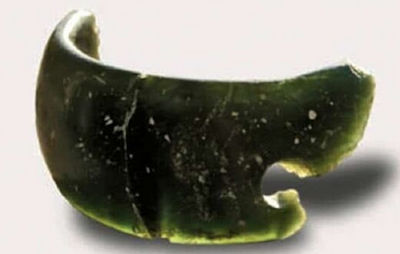
Figure 3
A bracelet fragment made of obsidian was found at Aşikli Höyük in Turkey, dated 7500 BC, fig. 4. It was not manufactured locally. The source of the obsidian could not be determined, but it was of high quality. As the researcher observed, the bracelet was polished to modern levels of precision using mechanical means. He also stated the bracelet showed evidence of pecking. This indicates that the carving was applied to the outside of a obsidian cylinder before the center was removed. Furthermore, a highly skilled craftsman made it, so the bracelet was not a one time production2. If the maker had the mechanical means to polish it, he doubtless had mechanical methods of creating blanks for shaping into finished products. Both bracelets are proof that sophisticated manufacturing processes existed many tens of thousands of years ago.

Figure 4
Antecedent Egyptians
Two types of distinctly different stonework can be found in Egypt. One is composed of very hard stones that were shaped with extremely high level of precision. Some of these stones were quarried and transported great distances. The people who achieved these remarkable accomplishments were the Antecedent Egyptians. Ancient Egyptians used primarily softer stones like alabaster and limestone that could be worked with hammer and chisel. Archaeological mixing of both together without acknowledging glaring technical differences is what creates the enigma of Egypt. Is it not the purpose of researchers to confront these serious questions rather than quietly ignoring them?
Egyptian statues that are the concern of this article were those made of very hard stone. Those are the anorthosite gneiss, porphyry, granite, graywacke, etc. that are not easily worked with a chisel. Moreover, the type of stone used had a major impact on the image projected by sculpture. In fig.(5a), the granite selected by Ramsesis III for his coffin lid was a very poor choice. The image is dominated by the stone's crystalline composition. By comparison, The makers of Ramesis II, fig.(5b) were careful in selecting and utilizing the stone's natural feature. A lighter band embedded within the gray granite was positioned to give the face a radiance. Ramesis's III choice of granite was probably determined by what could be delivered to the sculptor. In figs.5(c,d), there are comparisons between Ancient and Antecedent Egyptian methods of sculpting. Hammer and chisel were used to craft the pleats in Fig.5(c). The stone was easily worked soft alabaster. The pleats shown in fig.5(d), were crafted from the hard stone graywacke. They have what Chris Dunn repeatedly stresses, precision, and it was not achieved with hand tools.3 Antecedents had the means to select, acquire and sculpt stone that the Ancients never had.
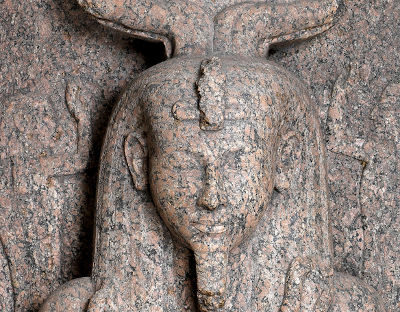
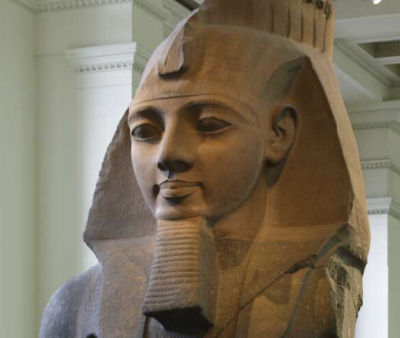
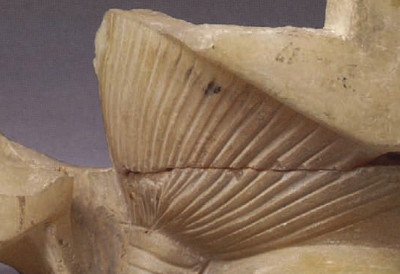
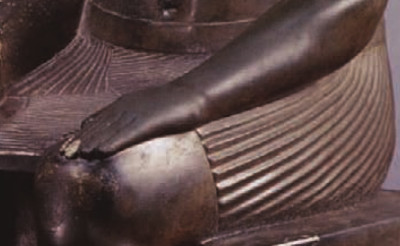
Figure 5
The Antecedents could select and retrieve a broad range of material. A good example is called Khafre Enthroned (not shown), one of the jewels of Cairo's museums. It was excavated from under the floor of his Valley Temple. The anorthosite gneiss used for Khafre's sculpture was brought 1200 km from the western desert. Transporting a 6+ ton block of stone to the Valley Temple was a typical Antecedent technical achievement. Why the statue was buried is a mystery. Burial was diametrically opposed to sculptural art's purpose. The only explanation for the burials was a perceived threat to the sculptures' well-being.
The only reason to bury statues was for protection and to avoid the fate of the Colossi of Memnon. The person featured in the massive statues is stated to be Amenhotep II. He might have chiseled his name on them, but he nor any other Ancient Egyptian had anything to do with them. The Antecedents created them. They quarried the quartzite sandstone, transported them 640 km and sculpted the figures. The catastrophic damage was declared the result of an earthquake, but the damage does not match that inflicted by a quake. It could only be the result of one or more SE. Geologic evidence in the Arctic shows SEs could occur in dense patterns. Fobbing these statues off on Amenhotep II without addressing their making, moving and destruction is not research. It is time to address the fact that someone quarried, moved and crafted the Colossi.

Figure 6
At an unusual site called the Karnak cachette, over eight hundred statues and seventeen thousand bronze items were found buried. Some statues were in pieces. Nearly half were block style sculptures said to be created during the Old Kingdom. Others are said to ranged from New Kingdom to Ptolemaic, however the range is probably questionable. ZPAs were active between 2200 BC and 4,000 BC4. Since plasma is highly destructive to metal, the concealment of a useful metal like bronze further substantiates the presence of a Peratt environment threat. Statues that are the crown jewels of the Cairo museums were also found buried.
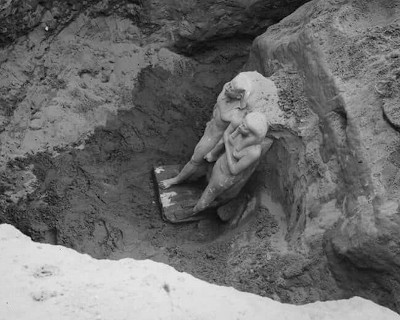

Figure 7
One of these jewels is called Menkaure and His Wife found at his Valley Temple. The graywacke created a striking image. The couple were not thrown into a pit, but were placed in it, fig. 7(a). The sculpture was intentionally buried. As per researchers, it was interned after the First Temple either 'fell into ruin' or was destroyed by a possible 'flash flood'. Neither of these two scenarios justify burying a statue. A flash flood is just another ad hoc 'literary contrivance' that only adds to the enigma that is Ancient Egypt. However, the destructive consequences of ZPAs would create strong motivation to secure a remarkable work of art.5
When clarifying evidence is at hand, it has not been pursued. For example, Sir Finders Petrie pointed out the vast field of debris, adjacent to the Gizah plateau, left from building the GP. He estimated the volume to be half that of the GP itself. In his excavation, he found wood, string, charcoal, etc. that could be dated6. No effort has been made to study this material even though a goldmine of information on GP's construction is contained in it. Failure to study the debris maintains the archaeological pretense that the monument was a tomb. The amount of engineering and complex construction is far more supportive of Chris Dunn's energy production theory than as a mortuary structure.7
A name is no guide to statue ownership. Pharaohs repeatedly appropriated the work of predecessors by putting their names to the works of others. It does not appear that many had deeply incised hieroglyphic names on them, so considerable uncertainty exists as to what statue belongs to which pharaoh. Besides pharaohs could have many names; Ramesis II had dozens. Hieroglyphic writing differed between Antecedents and Ancient Egyptians.
There were two forms of hieroglyphs. Antecedent Egyptians' hieroglyphs were deeply and perfectly incised in hard stone as seen in fig.(8b). Contours were added to the duck's feathers, and its toenails perfectly incised. All of their hieroglyphs were crisply defined. In hard stones, Ancient Egyptians hieroglyphs lack the same precision. Lines outlining the cartouche lack depth, sharpness and exactness, fig. (8a). These crude hieroglyphs were the product of hammer and chisel. Yet, no distinction has been made between the two; both have been treated as having the same originators.
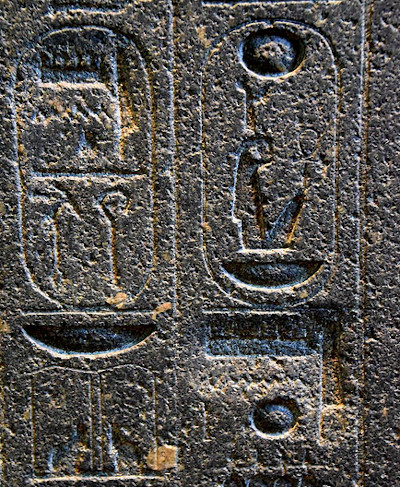
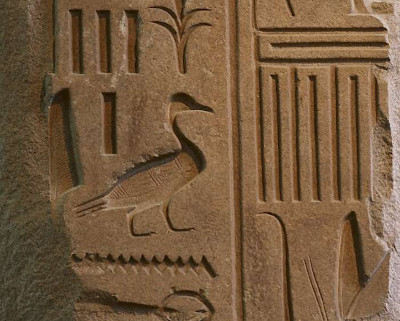
Figure 8
The hieroglyphs in fig. (9) are significant. Along with the above Menkaure dyad was found a triad sculpture. The cartouche of Menkaure had been chiseled on the base. Technology used to create precision images seen in fig. (8b) had been lost. Furthermore, the triad like the dyad in fig. (7b) was originally created without names. The precision sculpted hard stone statues have nothing to do with the Ancient Egyptians. Some of these statues do have deeply inscribed hieroglyphs applied when they were created. This is strong indication that Egyptian writing is very old. All were created by the Antecedent Egyptians for their own use and were reused by the Ancients.

Figure 9
Another remarkable Antecedent accomplishment was the manufacture of hard stone vessels. Over forty thousand were found under the Step Pyramid. The location may have been a manufacturing center for stone vessels. Many others have been found scattered across Egypt. Some could not be reproduced today. The vessel in fig.(10a) appears to have been created as a round bowl and then had its sides pressed in slightly. The 'single point stability' vessel rests horizontally on one point, fig (10b). Only a machine could have removed material with the precision necessary to keep the vessel balanced. The remarkable frog and ankh vessels, fig (10c,d), speak for themselves. Others were so small they could only have been created as toys for children. The soft stone, like alabaster, could easily be crafted into various shapes by Ancient Egyptians, but not the hard stones. All were products of Antecedent culture and not, as has been labeled by researchers, predynastic.
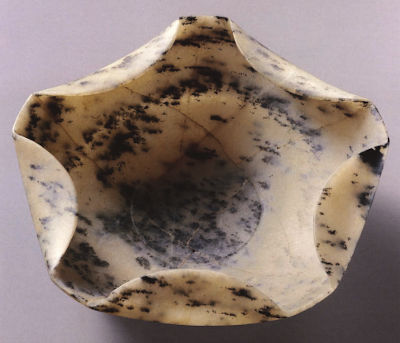
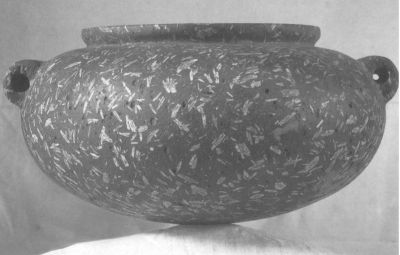

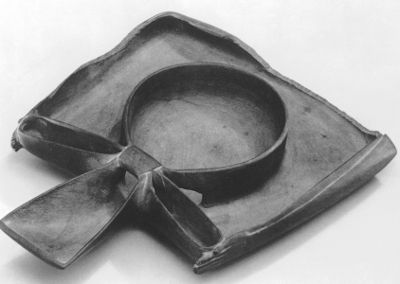
Figure 10
Because hard stone vessels have been found in large numbers in predynastic excavations, they have been treated as products of these cultures. The predynastic people acquired them by either trading, raiding or tomb robbing, but they did not make them. The youtube channel, unchartedx, presences a very good description of these vessels and particularly about how they are presented juxtaposed with the crude predynastic ceramic ware, fig. (11). No explanation has been advanced explaining how hard stone vessels and other objects like those in figs. (10,11) were manufactured.
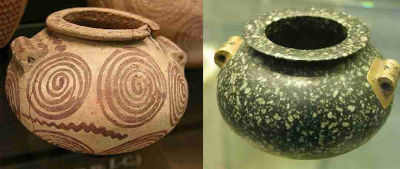
Figure 11
The website, unchartedx8, made a very good presentation of some megalithic columns at Tanis and Bastet. The craftsmanship was typical Antecedent precision stone work. The granite column in Fig.(12c) was sculpted from a single block of granite with the column and capital as a unit. Greeks and Romans always sculpted capitals separate from the column. The column's shape voids any suggestion that some type of rollers were used to position it. Both ends of the column had small holes centered on the central axis. Their probable roles will be covered in part 2. Like the Colossi, someone quarried, transported, and shaped massive blocks of granite to create them. Like the Colossi, there has been no rational explanation as to how this was done.
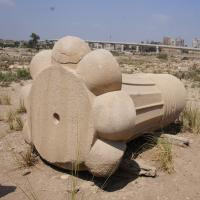
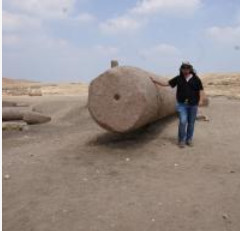
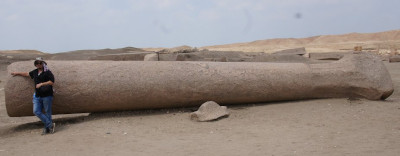
Figure 12
Conclusion
The PC was so severe it almost cleaved history in two. What researchers have refused to address has been the glaring disparity in technical skill exhibited by the evidence seen in Egypt. All evidence has been lumped into the 'Ancient Egypt' narrative which in turn created a vast game of pretending differences did not matter. Failure to address a distinction between the technical achievements of Ancient and Antecedent Egyptians has spawned the enigma of Egypt -nothing made sense. This in turn allowed HG nonsense to run rampant throughout research papers. Researchers treated stone as a sign of primitive culture rather than a necessary choice. Plasma is very destructive to metal. They had been through many episodes of Peratt Environments. They knew well the consequences. Part two will address how Antecedents created the evidence.
https://www.college-de-france.fr/site/en-jean-jacques-hublin/seminar-2016-11-15-18h00.htm (12:00).↩
Multi-scale tribological analysis of the technique of manufacture of an obsidian bracelet from Aşikli Höyük, L. Astruc et al; article↩
See Chris Dunn's interview here:https://rense.com/general96/dunnpyramid.html. Also his book, Lost Technologies of Ancient Egypt.↩
Mamoths disappeared from Wrangel Island without good explanation at about 3950 BC. Ancient Egyptians suddenly went deep building large 'tombs', some with stairs, starting about 4000 BC. Passage and chambered 'tombs' were being built during this time frame in the British Isles. Tell Lailan experienced a topographically irregular 'dust event' (colluvium) about 2250 BC. Nuraghi and Domus de Janas' were being built, but dating them has been challenging.↩
www.aeraweb.org/news/new-findings-from-the-menkaure-valley-temple/.↩
The Pyramids And Temples of Gizah, W. M. Flinders Petrie: p 85↩
See Chris Dunn's book, Giza Power Plant.↩
https://www.unchartedx.com/↩

